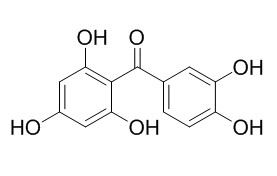Maclurin
Maclurin can effectively protect against mesenchymal stem cells (MSCs) oxidative damage induced by hydroxyl radical (OH) at 62.1-310.5 uM, the protective and antioxidant effects of maclurin can be primarily attributed to ortho-dihydroxyl groups, and ultimately to the relative stability of the ortho-benzoquinone form.Maclurin has anti-metastatic effect, the mechanism is by anti-oxidative activity and inhibition of Src/FAK-ERK-β-catenin signaling pathway.
Inquire / Order:
manager@chemfaces.com
Technical Inquiries:
service@chemfaces.com
Tel:
+86-27-84237783
Fax:
+86-27-84254680
Address:
1 Building, No. 83, CheCheng Rd., Wuhan Economic and Technological Development Zone, Wuhan, Hubei 430056, PRC
Providing storage is as stated on the product vial and the vial is kept tightly sealed, the product can be stored for up to
24 months(2-8C).
Wherever possible, you should prepare and use solutions on the same day. However, if you need to make up stock solutions in advance, we recommend that you store the solution as aliquots in tightly sealed vials at -20C. Generally, these will be useable for up to two weeks. Before use, and prior to opening the vial we recommend that you allow your product to equilibrate to room temperature for at least 1 hour.
Need more advice on solubility, usage and handling? Please email to: service@chemfaces.com
The packaging of the product may have turned upside down during transportation, resulting in the natural compounds adhering to the neck or cap of the vial. take the vial out of its packaging and gently shake to let the compounds fall to the bottom of the vial. for liquid products, centrifuge at 200-500 RPM to gather the liquid at the bottom of the vial. try to avoid loss or contamination during handling.
Mol Immunol. 2016, 78:121-132
Molecules.2023, 28(4):1785.
Int J Mol Sci.2022, 23(13):7115.
Korean J. of Food Sci. and Tech2016, 172-177
J Pharm Biomed Anal.2018, 151:32-41
Food Funct.2022, 13(14):7638-7649.
US20170000760 A12016, 42740
Natural Product Res.&Deve.2022, 1001-6880.
Fitoterapia.2018, 124:92-102
Drug Chem Toxicol.2020, 1-12.
Related and Featured Products
Chem Biol Interact. 2014 Aug 5;219:221-8.
Maclurin protects against hydroxyl radical-induced damages to mesenchymal stem cells: antioxidant evaluation and mechanistic insight.[Pubmed:
24973644]
Maclurin, an exceptional member of phytophenol family, was found to effectively protect against mesenchymal stem cells (MSCs) oxidative damage induced by hydroxyl radical (OH) at 62.1-310.5 μM.
METHODS AND RESULTS:
Antioxidant assays indicated that Maclurin could efficiently protect DNA from OH-induced damage at 114.6-382.2 μM, and scavenge OH, DPPH (1,1-diphenyl-2-picrylhydrazyl radical), ABTS(+) (2,2'-azino-bis(3-ethylbenzothiazoline-6-sulfonic acid radical), and bind Cu(2+) (IC50 values were respectively 122.87 ± 10.14, 10.15 ± 0.85, 0.97 ± 0.07, and 133.95 ± 11.92 μM). HPLC-DAD and HPLC-ESI-MS/MS analyses of the end-product of Maclurin reaction with DPPH clearly suggested that Maclurin (m/z = 261.12 [M-H](-)) donated two hydrogen atoms to DPPH (m/z = 394.06 [M](+)) to form ortho-benzoquinone moiety (λmax = 364 nm; m/z = 259.06 [M-H](-), loss of m/z = 28) and DPPH2 molecule (m/z = 395.03, 396.01), via hydrogen atom transfer (HAT) or sequential electron (e) proton transfer (SEPT), not radical adduct formation (RAF) mechanisms.
CONCLUSIONS:
Therefore, we concluded that: (i) Maclurin can effectively protect against OH-induced damages to DNA and MSCs, thereby it may have a therapeutic potential in prevention of many diseases or MSCs transplantation; (ii) a possible mechanism for Maclurin to protect against oxidative damages is OH radical-scavenging; (iii) Maclurin scavenges OH possibly through metal-chelating, and direct radical-scavenging which is mainly via HAT or SEPT mechanisms; and (iv) the protective and antioxidant effects of Maclurin can be primarily attributed to ortho-dihydroxyl groups, and ultimately to the relative stability of the ortho-benzoquinone form.
Mol Cell Biochem. 2015 Apr;402(1-2):243-52.
Maclurin suppresses migration and invasion of human non-small-cell lung cancer cells via anti-oxidative activity and inhibition of the Src/FAK-ERK-β-catenin pathway.[Pubmed:
25630491]
Recent reports indicated that ROS is closely related with cancer metastasis. ROS targets major signaling molecules which are known to be involved in migration and invasion of cancer cells.
METHODS AND RESULTS:
Here we report that Maclurin, a major phenolic component of ethanol extracted mulberry twigs, exerts anti-metastatic effect in A549 human non-small-cell lung cancer cells. Maclurin suppresses intracellular ROS level in A549 human non-small-cell lung cancer cells. Also, Maclurin down-regulates Src and ERK, which are well known to be regulated with redox state. Suppressed Src/FAK and ERK signalings activate GSK3-β, thus inhibiting nuclear accumulation of β-catenin. As a result, transcriptional expressions of two major gelatinases (MMP-2 and MMP-9) were significantly down-regulated. Consequently, migration and invasion of A549 human non-small-cell lung cancer cells were attenuated. Anti-metastatic effect of Maclurin on A549 human non-small-cell lung cancer cells were diminished by the treatment of hydrogen peroxide, thus further implicating that the effect of Maclurin may be strongly related with its anti-oxidative activity.
CONCLUSIONS:
Thus, our data indicate that the anti-metastatic effect of Maclurin is exerted by anti-oxidative activity and inhibition of Src/FAK-ERK-β-catenin signaling pathway.



